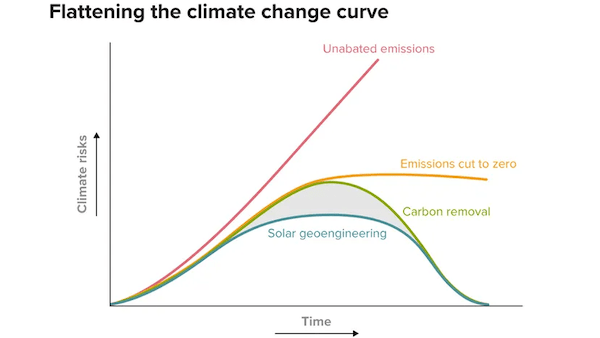Tweaking the chemical composition of Earth’s oceans and atmosphere to slow global warming is an idea that most scientists have resisted due to concerns about the unintended consequences. Nonetheless, more researchers and governments are seriously considering possible applications as they seek ways to mitigate increasing weather disasters and other symptoms of a warming planet.
Known as “geoengineering,” the methods involved deliberately manipulate the environment with the intent of counteracting greenhouse gas (GHG) pollution. While there are dozens of different techniques, most fall into two categories:
Solar Radiation Management (SRM) or “solar geoengineering,” strategies aim to reflect a small proportion of the Sun’s energy back into space, counteracting the temperature rise caused by increased levels of greenhouse gases in the atmosphere which absorb energy and raise temperatures. SRM techniques, which include space reflectors and stratospheric aerosols, are considered cheap and quick, but imperfect. Additionally, SRM techniques, if applied, would need to be maintained or conducted repeatedly, and indefinitely, as they do not actually remove the root cause of global warming- GHG emissions.
Greenhouse Gas Removal (GGR), aka “carbon geoengineering,” techniques aim to remove carbon dioxide or other greenhouse gases from the atmosphere, directly countering the increased greenhouse effect and ocean acidification. These techniques would have to be implemented on a global scale to have a significant impact. GGR methods, which include ocean fertilization, enhanced weathering, and ocean alkalinity enhancement, are expensive and slow, but considered perfect (precise) and can generate negative net emissions.
Supporters of geoengineering say it is necessary given the lack of progress in international agreements in mitigating GHG emissions and the increasing frequency of extreme climate events. Most propose using the techniques in order to delay the worst impacts of climate change while the world continues the transition to a carbon-free economy.
The main concern among critics is that the sheer scale of many of these proposals would have massive and unpredictable impacts on the environment. Some also believe any negative impacts will be disproportionately born by poor nations, especially those in the global south. There are also very real concerns about the potential impacts on global food production systems, as any negative consequences are not likely be reversed quickly, if at all.
Most global governments, the US included, believe the current level of understanding of the implications of such interventions is not sufficient to deploy them. While solar radiation management is currently legal in most nations, there has been a de facto global moratorium in place since 2010, when it was agreed by governments under the Convention on Biological Diversity, with exceptions for small-scale scientific research studies.
In 2023, the White House released a report laying out guidelines for solar geoengineering research. In it, they concluded that while some research conducted so far is promising, it is also limited and there remain a lot of unknown risks. For example, stratospheric aerosol injections could accelerate ozone depletion and reduce biodiversity. Other “known unknowns” include potential changes in patterns of precipitation, sea-level rise, terrestrial vegetation, coral reefs, crop production, and other ecosystem changes. It could also harm human health by increasing particulate matter, for instance.
It’s worth noting that the UN has recently had serious discussions about geoengineering. A draft resolution presented last month at the U.N. Environment Assembly (UNEA) calling for more research into SRM technologies was withdrawn after failing to reach consensus. Some countries led by the African Group of countries wanted to ban SRM, while others led by Switzerland had pushed to set up an expert panel to research the nascent approach.
These discussions are notable because just a few years ago, geoengineering was almost universally rejected by global leaders and scientists alike. But this year alone, at least three geoengineering field experiments are planned in the US, Israel, and Australia, aimed at laying the groundwork for more large-scale programs. (Sources: Oxford University, Anthropocene, Science, The Wall Street Journal)








